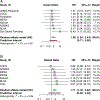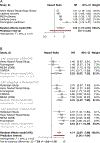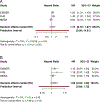Assessment of Subclinical Atherosclerosis in Asymptomatic People In Vivo: Measurements Suitable for Biomarker and Mendelian Randomization Studies
- PMID: 38150519
- PMCID: PMC10753091
- DOI: 10.1161/ATVBAHA.123.320138
Assessment of Subclinical Atherosclerosis in Asymptomatic People In Vivo: Measurements Suitable for Biomarker and Mendelian Randomization Studies
Abstract
Background: One strategy to reduce the burden of cardiovascular disease is the early detection and treatment of atherosclerosis. This has led to significant interest in studies of subclinical atherosclerosis, using different phenotypes, not all of which are accurate reflections of the presence of asymptomatic atherosclerotic plaques. The aim of part 2 of this series is to provide a review of the existing literature on purported measures of subclinical disease and recommendations concerning which tests may be appropriate in the prevention of incident cardiovascular disease.
Methods: We conducted a critical review of measurements used to infer the presence of subclinical atherosclerosis in the major conduit arteries and focused on the predictive value of these tests for future cardiovascular events, independent of conventional cardiovascular risk factors, in asymptomatic people. The emphasis was on studies with >10 000 person-years of follow-up, with meta-analysis of results reporting adjusted hazard ratios (HRs) with 95% CIs. The arterial territories were limited to carotid, coronary, aorta, and lower limb arteries.
Results: In the carotid arteries, the presence of plaque (8 studies) was independently associated with future stroke (pooled HR, 1.89 [1.04-3.44]) and cardiac events (7 studies), with a pooled HR, 1.77 (1.19-2.62). Increased coronary artery calcium (5 studies) was associated with the risk of coronary heart disease events, pooled HR, 1.54 (1.07-2.07) and increasing severity of calcification (by Agaston score) was associated with escalation of risk (13 studies). An ankle/brachial index (ABI) of <0.9, the pooled HR for cardiovascular death from 7 studies was 2.01 (1.43-2.81). There were insufficient studies of either, thoracic or aortic calcium, aortic diameter, or femoral plaque to synthesize the data based on consistent reporting of these measures.
Conclusions: The presence of carotid plaque, coronary artery calcium, or abnormal ankle pressures seems to be a valid indicator of the presence of subclinical atherosclerosis and may be considered for use in biomarker, Mendelian randomization and similar studies.
Keywords: aorta; atherosclerosis; carotid arteries; myocardial infarction; phenotype.
Conflict of interest statement
Figures




References
-
- Kawai K, Finn AV, Virmani R. . Subclinical atherosclerosis part 1. What is it? Csn it be defined at the histological level? Arterioscler Thromb Vasc Biol 2923. - PubMed
-
- Team RStudio. RStudio: Integrated Development Environment for R RStudio, PBC, Boston, MA. 2020.
-
- Harrer M, Cuijpers P, Furukawa T, DD E. Doing Meta-Analysis in R. A Hands on Guide https://bookdown.org/MathiasHarrer/Doing_Meta_Analysis_in_R/. 2019.
-
- Grundy SM, Stone NJ, Bailey AL, Beam C, Birtcher KK, Blumenthal RS, Braun LT, de Ferranti S, Faiella-Tommasino J, Forman DE, et al. 2018 AHA/ACC/AACVPR/AAPA/ABC/ACPM/ADA/AGS/APhA/ASPC/NLA/PCNA Guideline on the Management of Blood Cholesterol: Executive Summary: A Report of the American College of Cardiology/American Heart Association Task Force on Clinical Practice Guidelines. Circulation 2019;139:e1046–e1081. doi: 10.1161/CIR.0000000000000624 - DOI - PubMed

